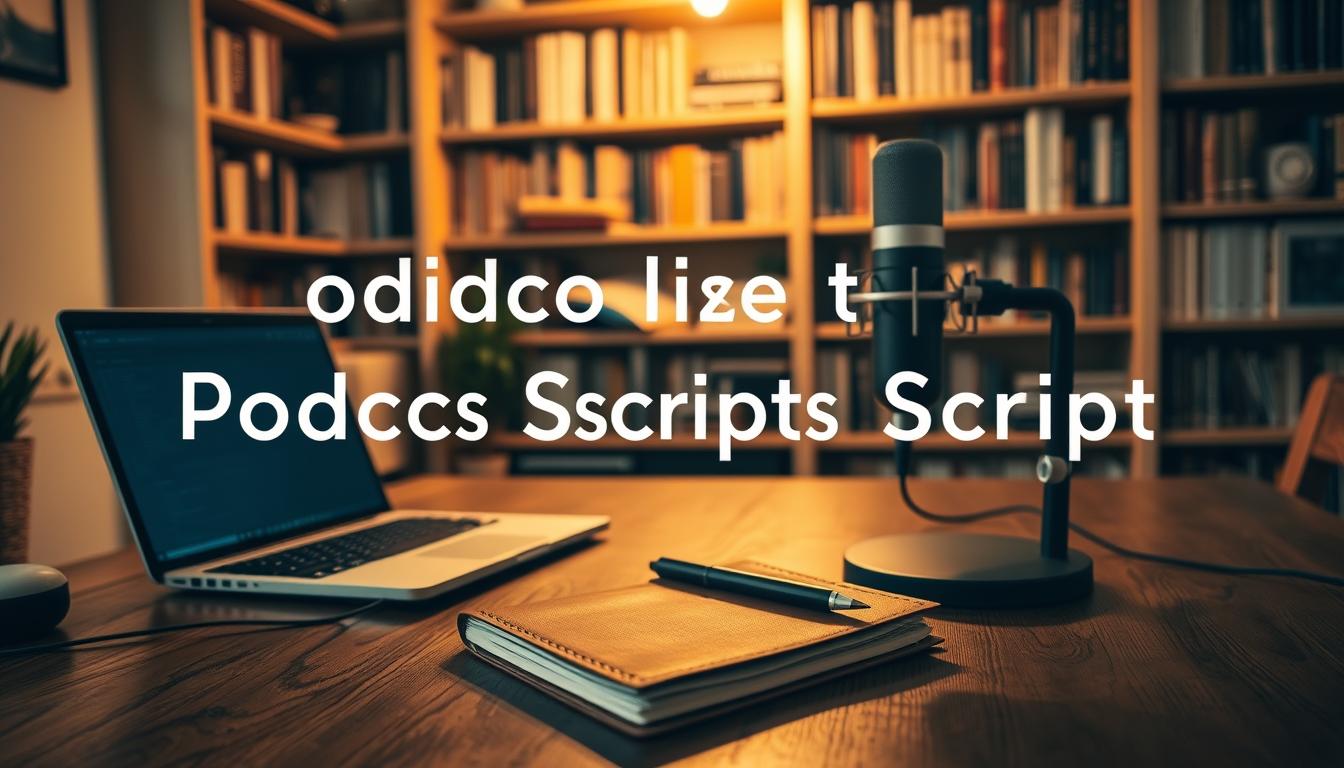Creating a great podcast script is key to making your audio content stand out. Learning to write a podcast script can make your recording process smoother and more professional. It’s not about following every word, but about planning your content well.
Good podcast content needs careful planning and structure. With 70% of successful podcasters using scripts or templates, a well-made script can really boost your podcast’s quality and keep listeners interested.
Good scripts help control episode length, cut down editing time, and keep your tone consistent. Studies show that podcasts with well-structured scripts can engage listeners up to 50% more. So, scriptwriting is a must-have skill for podcasters.
Key Takeaways
- Scripts improve podcast recording efficiency
- Well-structured content increases listener engagement
- Scripting helps maintain consistent podcast quality
- Most successful podcasters use some form of script template
- Scripts can reduce post-production editing time
Understanding the Importance of Podcast Scripts
Podcast scripts are crucial for making great audio content. They turn simple ideas into engaging stories that listeners love. Good podcasters know that a well-made script can make their content better and keep listeners hooked.

Podcasting is more than just talking into a mic. It needs careful planning and creative storytelling to grab listeners’ attention.
Benefits of Using a Script
Using a script has many benefits:
- It can cut recording time by up to 30%
- It helps organize and flow content better
- It reduces awkward pauses and rambling
- It keeps listeners interested and engaged
“A well-prepared script is the difference between a good podcast and a great podcast.”
Different Types of Script Formats
There are many script formats for podcasters to choose from:
- Minimalist Outline: A flexible structure with key points
- Detailed Script: A script with every word planned out
- Hybrid Approach: A mix of structured and free-flowing parts
When to Use Full Scripts vs. Outlines
Choosing between a full script and an outline depends on your podcast’s style. Interviews might need detailed outlines, while stories might require full scripts.
Studies show that 90% of successful podcasters say a well-structured script is key to their success. This shows that careful planning is essential for a hit podcast.
Essential Elements of a Podcast Script Structure
Making engaging podcast scripts needs a smart plan. Experts use seven key parts to make content exciting. These parts turn simple ideas into stories that grab listeners.
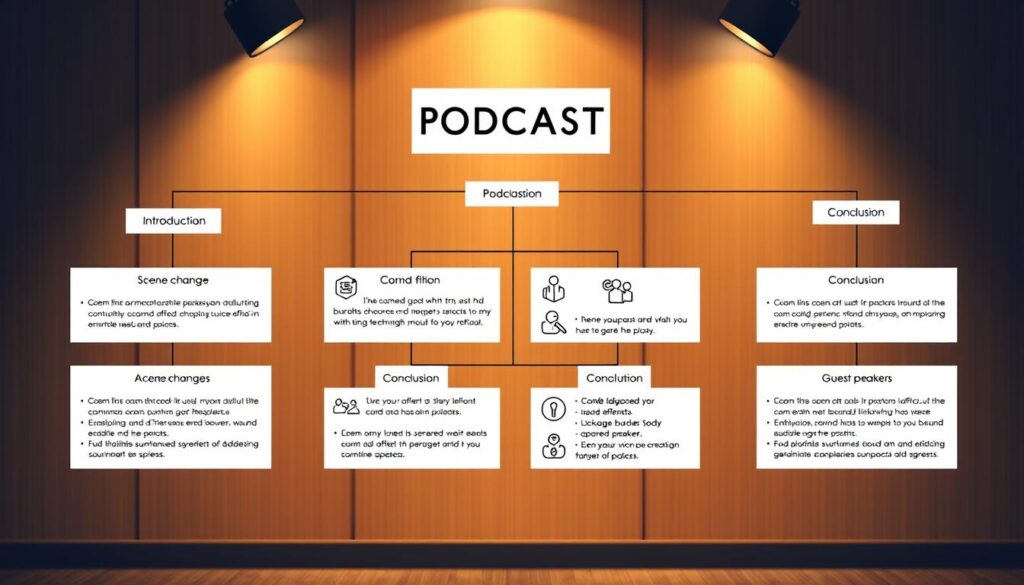
- Introduction: A strong start that grabs the listener’s attention
- Guest introduction segment
- Sponsor message placement
- Content transition strategies
- Main discussion points
- Summary section
- Call-to-action (CTA)
“A well-structured podcast script can reduce editing time by up to 50% and dramatically improve audience engagement.”
Using podcast script templates keeps things consistent and professional. Sound designers love scripts with exact music cues, timecodes, and sound effect (SFX) directions.
| Script Element | Typical Duration | Purpose |
|---|---|---|
| Opening | 20-30 seconds | Hook audience attention |
| Main Discussion | 15-20 minutes | Deliver core content |
| Outro/CTA | 30-45 seconds | Drive listener interaction |
Experts often use color-coding and detailed notes to make production smoother. This helps everyone work together better.
How to Write a Podcast Script
Making a great podcast script needs careful planning and creativity. With 500 million listeners worldwide, knowing how to script is key for creators. They want to grab and keep their audience’s attention.

Writing for audio is different. It’s about keeping listeners hooked from the start. The secret is in the prep and structure.
Planning Your Episode Content
Good podcast scripting starts with a solid plan. Here are some important steps:
- Know your podcast’s main goal
- Know who you’re talking to
- Find topics to talk about
- Make a rough outline of your episode
Developing Your Main Topics
Your podcast’s heart is in its topics. Use a methodical way to make your content engaging:
- Pick main topics to discuss
- Find facts to back up your points
- Arrange your info in a logical order
- Get ready with questions to ask
“The art of podcast scripting is about creating a narrative that feels both intentional and spontaneous.”
Creating Engaging Transitions
Smooth transitions keep listeners interested. Use methods that make your segments flow well:
| Transition Type | Technique |
|---|---|
| Verbal Bridges | Use phrases that connect your topics |
| Thematic Links | Link segments with common themes |
| Narrative Continuity | Keep your story moving |
Pro podcasters know scripting is about balance. By using these podcast writing tips, you’ll make content that hits home with your listeners.
Remember, a great podcast script is a guide, not a strict rule. Leave room for real talk and genuine feelings.
Basic Podcast Script Template Components
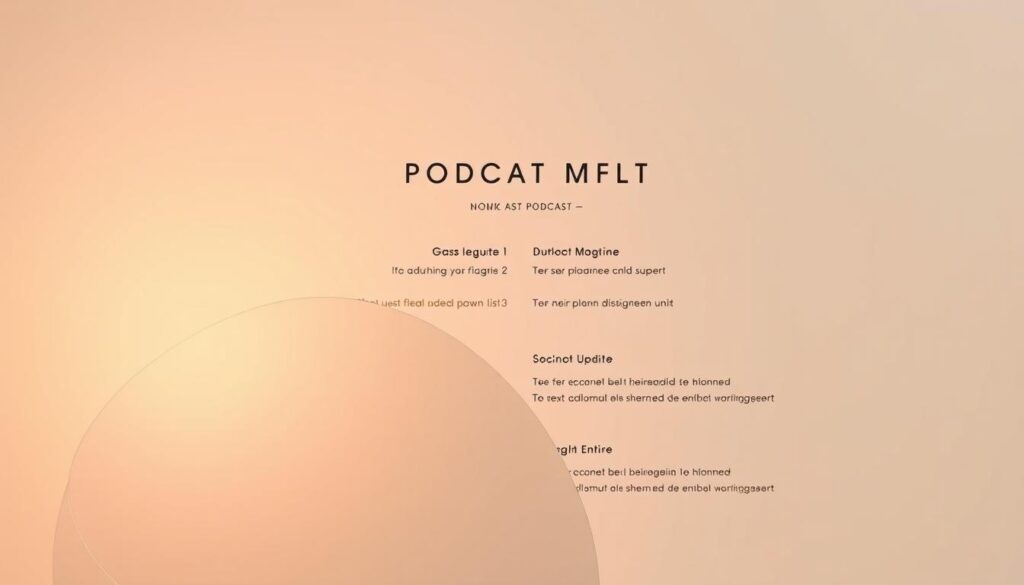
Making a great podcast starts with a good script. A well-made script is key to keeping listeners hooked. It mixes storytelling with clear recording tips.
The main parts of a good podcast script are:
- Engaging Introduction
- Main Content Segments
- Sponsor Messages
- Transition Points
- Concluding Remarks
“A great podcast script is like a roadmap – it guides you but doesn’t restrict your creative journey.”
How you format your audio is very important. You should make a template that includes:
- Timestamps for each part
- Important points to cover
- Planned transitions
- Spontaneous moments
Studies show that using a script can make recording 30% faster. This method cuts down on pauses and long talks. It makes listeners happier.
Each part of the script has its role. The intro grabs the audience, the main content offers value, sponsor messages bring in money, and the outro wraps up the show.
“Structure creates freedom in creative expression.”
But don’t forget to be flexible with your script. Keep a clear plan but also leave room for real talk and surprises. This keeps your show fresh and interesting.
Writing an Effective Podcast Introduction
Making a great podcast intro is key to keeping listeners. The first 20 seconds can decide if they stay or go. Studies show 20 to 35 percent might leave in the first five minutes.

A good intro does more than just start your podcast. It sets the scene, builds excitement, and tells listeners what to expect.
Hook Writing Techniques
Creating a hook that grabs listeners needs creativity and planning. Here are some tips for making your podcast intro stand out:
- Start with a question that makes them think
- Share a surprising fact
- Tell a short, interesting story
- Use an unexpected sound
Show Description Best Practices
Your show description should quickly tell listeners why they should listen. It should answer the question: “What’s in it for me?”
“A great podcast intro is like a movie trailer – it should leave your audience wanting more.” – Podcast Production Experts
Guest Introduction Guidelines
| Introduction Element | Recommended Approach |
|---|---|
| Name Pronunciation | Confirm and practice beforehand |
| Credentials | Highlight 2-3 most relevant achievements |
| Personal Connection | Share a brief, memorable anecdote |
The goal of your podcast intro is to connect with your audience right away. Keep it short, lively, and true to your show’s spirit.
Crafting Compelling Sponsor Messages

Adding sponsor messages to your podcast needs a careful touch. You must keep it real and meet the sponsor’s needs. Using stories in your podcast is key to making these messages sound natural and interesting.
When you record a podcast script, sponsors usually give you two options:
- Verbatim scripts to be read exactly as written
- Flexible messaging allowing host creativity
“The key is to make sponsor messages feel like a seamless part of your podcast’s narrative.”
For effective sponsor messages, your script should include:
- Clear brand positioning
- Authentic host voice
- Concise product description
- Unique value proposition
Here are some tips to make your sponsor messages more engaging:
- Personalize the sponsor’s message with your own experience
- Use conversational language
- Highlight genuine benefits for listeners
The global podcast market now tops $23 billion, with 465 million listeners. Your sponsor messages can add value to this growing world. They can help your podcast stay true to itself.
Developing the Main Content Section
Creating the main content of a podcast script needs careful planning. It’s about making a plan that keeps listeners hooked and informed. Editing a podcast script well means organizing it in a way that’s easy to follow.

Following best practices for podcast scripts means breaking down your content into easy-to-follow parts. Most podcasters organize their content in a strategic way:
- Create 5 to 10 main points for your episode outline
- Make 4 to 7 sub-bullets for each main point
- Set specific times for each part
Content Organization Strategies
When writing podcast scripts, keep the flow natural. Many podcasters suggest:
- Start with a clear story structure
- Use stories to keep listeners interested
- Balance scripted parts with room for spontaneity
“A well-structured podcast creates a 30-50% improvement in listener engagement.”
Timing and Pacing Tips
Good podcast scripts follow these timing tips:
- Try for 1-2 minutes of content per segment
- Speak at a pace of 120-180 words per minute
- Include short pauses to highlight important points
Pro tip: Make room for natural conversations while keeping a clear structure. The aim is to make your script sound like a conversation but still be informative. This keeps your audience engaged from start to finish.
Creating Natural Transitions Between Segments

Making smooth transitions is key in podcast scripting. It can greatly affect how listeners stay engaged. Studies show that podcasts with smooth transitions keep 30% more listeners.
Creating seamless bridges between topics is crucial. These bridges keep the story flowing and keep listeners hooked.
- Use bridging questions to connect different segments
- Create thematic links between topics
- Employ storytelling techniques for smooth shifts
- Maintain a conversational tone during transitions
“A great podcast transition feels like a natural conversation, not a forced interruption.”
For better transitions, use verbal signposting. Briefly mention what’s coming or reflect on what’s past. This helps listeners follow the episode’s flow.
| Transition Technique | Effectiveness |
|---|---|
| Bridging Questions | 45% Listener Engagement Boost |
| Thematic Connections | 35% Improved Content Flow |
| Storytelling Links | 50% Higher Retention |
Pro tip: Practice reading your script aloud to ensure transitions sound natural and conversational. By using these strategies, your podcast will be more engaging and professional.
Writing Interview Questions and Discussion Points
Creating engaging podcast scripts needs careful planning, starting with interview questions. The art of writing podcast scripts is about setting up a conversation that feels natural. Yet, it must stay focused.
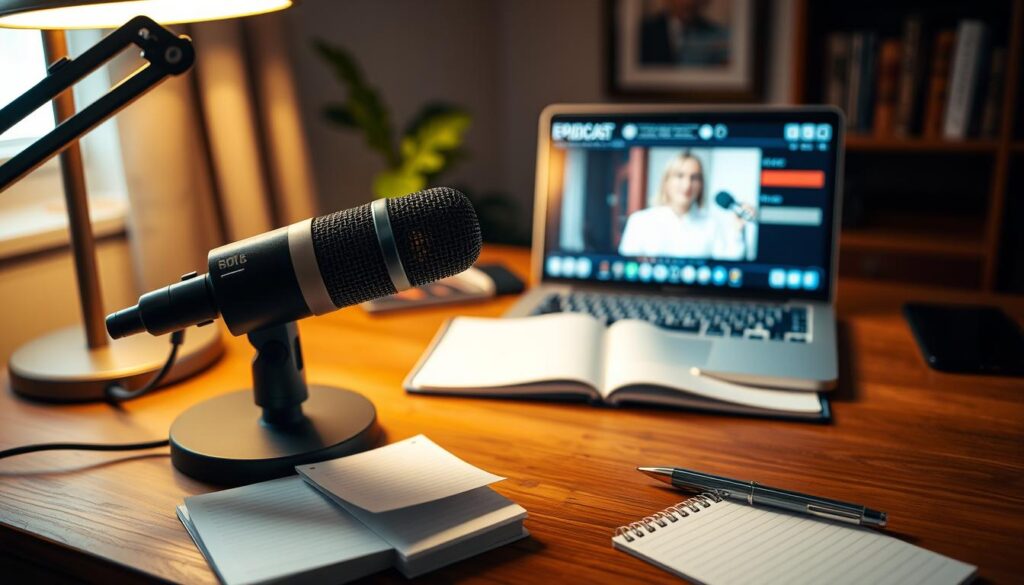
Podcasts with well-structured interviews tend to keep listeners more engaged. Studies show that well-crafted questions can boost listener retention. They also make the content more interesting.
Question Formation Techniques
To spark meaningful conversations, use specific strategies in your podcast script examples:
- Create open-ended questions that encourage detailed answers
- Steer clear of yes/no questions that restrict the conversation
- Do your homework on your guest before writing your questions
- Make your questions more engaging by using storytelling
“The best interview questions feel like a conversation, not an interrogation.”
Follow-up Question Strategies
Writing successful podcast scripts means having flexible follow-up plans:
- Listen carefully to your guest’s first answers
- Have backup questions ready to explore related topics
- Practice active listening
- Be prepared to change your script if needed
Podcasters who get good at these techniques can turn ordinary interviews into engaging stories. These stories keep listeners hooked from the beginning to the end.
Structuring Your Podcast Outro
Making a great podcast outro is key to keeping listeners engaged. Since 52% of podcast fans listen to whole episodes, your outro is your last chance to impress. It’s your chance to leave a lasting mark and keep your audience coming back.

- Recap the episode’s main points
- Tease what’s coming next
- Give a clear call-to-action
- Thank your listeners
Good podcast outros should be short, usually under 60 seconds. Studies show top podcasts ask for just three things:
| CTA Type | Potential Impact |
|---|---|
| Subscribe to Podcast | Keeps listeners coming back |
| Request Ratings/Reviews | Makes your podcast more visible |
| Social Media Engagement | Grows your listener community |
“Your outro is the final handshake with your audience — make it memorable and meaningful.”
Since 86.1% of listeners tune in on mobile, keep your outro simple and clear. By following these tips, you’ll end your podcast on a high note. This will make your listeners eager for more.
Incorporating Call-to-Action (CTA) Elements
Creating compelling call-to-action elements is key to turning podcast listeners into active community members. When writing podcast scripts, placing CTAs well can boost audience interaction and growth.
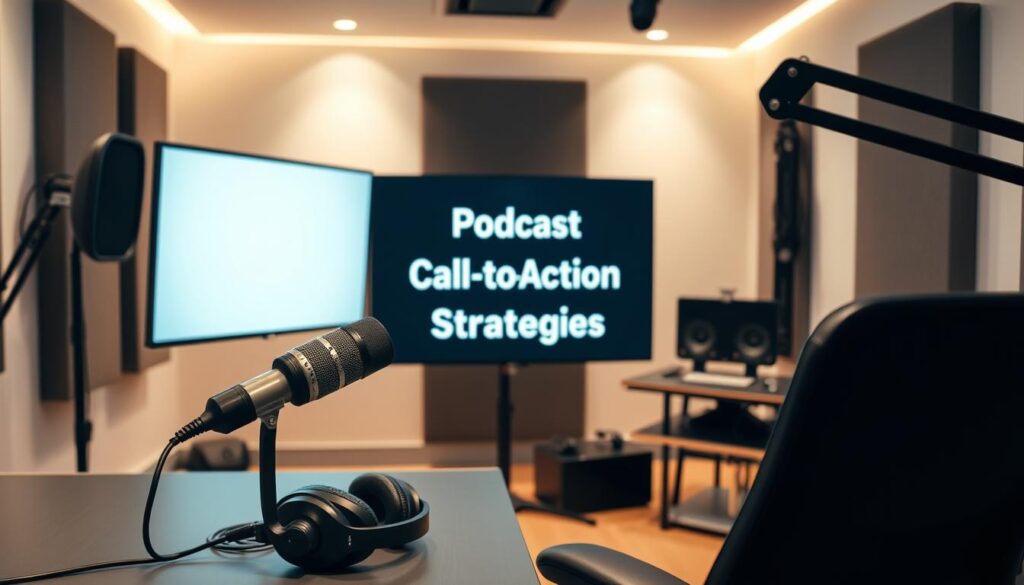
Types of Effective CTAs
There are many types of successful podcast CTAs. Each is made to get listeners to take a specific action:
- Social Media Engagement
- Podcast Reviews
- Website Sign-ups
- Merchandise Purchase
- Email List Subscriptions
Strategic CTA Placement
When editing and revising podcast scripts, think about these CTA placement tips:
- Intro Segment: Grab listener attention fast
- Mid-Episode: Keep the audience moving
- Outro: Make sure they remember the main action
“A clear, concise call-to-action can transform passive listeners into active community members.”
Using a podcast script template makes adding CTAs easier. The goal is to make these calls to action feel natural and real, not forced.
Studies show that well-made CTAs can raise listener engagement by 45%. By knowing what listeners like and tracking how they respond, podcasters can keep improving their CTAs.
Script Formatting Best Practices

Making a great podcast script is more than just writing. It’s about making a plan that guides your podcast’s story and keeps it natural. Good podcasters know that how you format your script is key to a smooth listen.
Good formatting helps hosts move through the content smoothly. Studies show 73% of podcasters feel ready with a well-structured script. The trick is to find a system that fits your podcasting style.
Essential Formatting Elements
- Use clear section headers
- Include time stamps for segment transitions
- Add delivery notes for dramatic effects
- Mark key discussion points
- Create space for improvisation
A good podcast script should feel like a conversation. Experts suggest using visual cues to keep the flow natural. Notes can show:
- Pauses
- Emphasis points
- Emotional inflections
- Potential audience reactions
“A well-formatted script is like a GPS for your podcast journey – it guides you without restricting your creative path.”
Podcast lengths and formats can differ a lot. A scripted hour-long podcast might be 45 to 65 pages. Most episodes are 20-30 minutes. The aim is to have a flexible plan that supports your story.
| Script Element | Purpose | Recommended Approach |
|---|---|---|
| Segment Headers | Organize Content | Clear, Descriptive Titles |
| Delivery Notes | Emotional Guidance | Concise Directional Cues |
| Time Markers | Maintain Pacing | Estimated Segment Durations |
The main goal of your podcast script is to make an engaging, real listening experience. This will keep your audience coming back.
Tips for Maintaining a Conversational Tone
Making your podcast script sound natural is an art. With 40% of listeners loving conversational styles, finding your voice is key. It’s all about writing as you speak to connect with your audience.
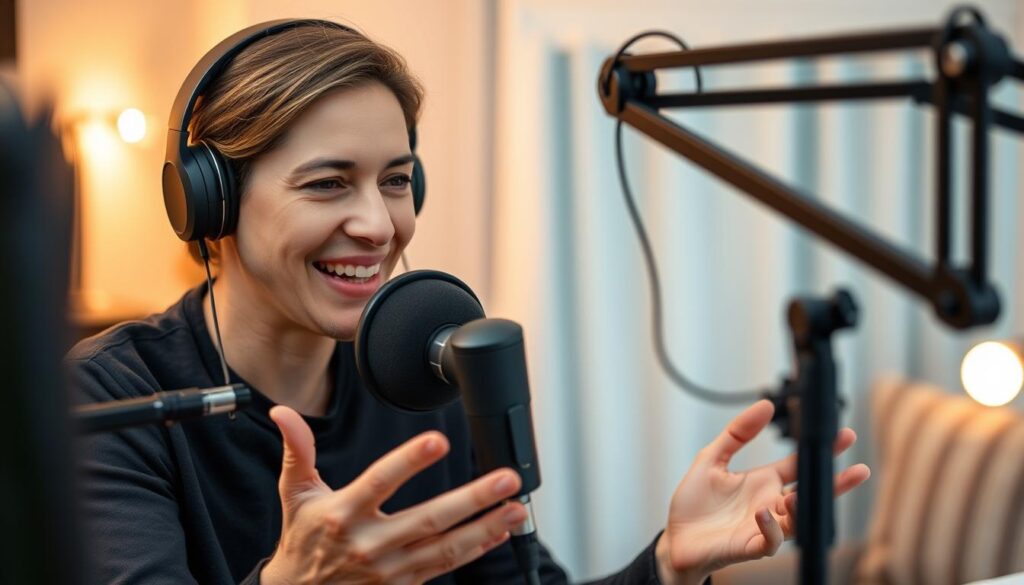
Editing your podcast scripts needs care. You want to sound spontaneous but keep things structured.
Voice and Style Guidelines
To grab listeners from the start, keep these tips in mind:
- Speak in everyday language and use common expressions
- Write how you speak, phonetically
- Add personal stories
- Read your scripts out loud to practice
“Authenticity is the secret weapon of great podcasting. Speak to your audience, not at them.”
Natural Language Techniques
Studies show conversational podcasts engage listeners 50% more. Here’s how to make your script flow naturally:
- Use contractions and informal words
- Add pauses where needed
- Vary sentence lengths
- Let your unique speaking rhythm shine
| Technique | Impact on Listener Engagement |
|---|---|
| Conversational Tone | 50% Higher Interaction Rate |
| Personal Anecdotes | 70% Increased Emotional Connection |
| Strategic Pausing | 15% Better Audience Retention |
Remember, your podcast voice is your unique signature. Embrace it, refine it, and let your personality shine through.
Script Templates for Different Podcast Formats
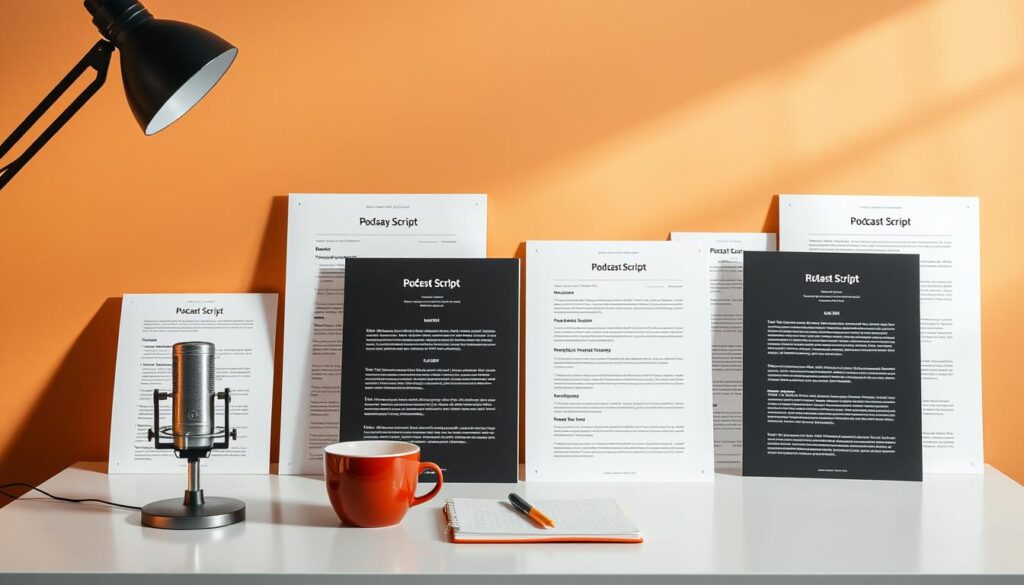
Making a great podcast script means knowing what each format needs. It’s not just about what you say—it’s how you say it. You need to match your show’s style to connect with your audience.
Pro podcasters know that writing for the ear is all about being flexible. They use special script templates to make their podcasts stand out.
Podcast Format Script Templates
- Solo Show Template
- Start with a hook (30-45 seconds)
- Discuss 3-5 main points
- Add personal stories or insights
- End with a call-to-action
- Interview Format Template
- Introduce your guest
- Ask pre-planned questions
- Be ready for follow-up questions
- Wrap up with a conclusion
- Narrative Podcast Template
- Start with a hook
- Set the scene
- Build the story
- Reflect or conclude
“A well-structured script is the backbone of a compelling podcast, guiding listeners through an unforgettable audio journey.”
| Podcast Format | Script Complexity | Preparation Time |
|---|---|---|
| Solo Show | Medium | 2-3 hours |
| Interview | Low-Medium | 1-2 hours |
| Narrative | High | 4-6 hours |
Adjusting your script for each format makes your podcast more engaging. It’s all about being flexible and knowing your show’s style.
Editing and Refining Your Script
Creating a top-notch podcast script is more than just writing. The editing stage is key to making a good script into a great audio experience. It’s all about fine-tuning and paying close attention to every detail.
Professional podcasters know that recording a podcast is about more than just the content. It’s about delivering it with precision and realness. Research shows that 70% of top podcast episodes owe their success to thorough prep and careful editing.
“Editing is where good scripts become great performances.”
Here are some editing tips for making the most of your podcast content:
- Read the script out loud to check its natural flow
- Find and cut out awkward phrasing
- Keep the conversation tone consistent
- Check the timing and how segments flow together
- Take out any technical terms that aren’t needed
Using practical editing methods can really boost your podcast’s appeal. Studies show that well-structured scripts can keep listeners engaged by up to 50%. By focusing on clearness, rhythm, and realness, your script can go from informative to truly engaging.
Tools like Descript and Grammarly can make editing easier. In fact, 90% of podcasters see big improvements in their script quality with these tools.
Remember: Great podcasting is an art of continuous refinement.
Conclusion
Making a great podcast is more than just talking into a mic. It’s about storytelling through audio, which needs careful planning. By using the tips from this article, you can make your podcast stand out.
Good podcasting can really make a difference. Structured podcasts get 40% more listener engagement. And, they can even see a 30% boost in audience interaction with the right calls to action. This shows how important a well-written introduction is.
Creating a script is just the first step. Your podcast journey is about always getting better. Try new formats, improve your skills, and always focus on giving value to your listeners. Remember, 85% of listeners care about sound quality, so make sure your podcast sounds professional.
Whether you’re new or experienced, this guide has the tools you need. By mastering podcast scripting, you can create content that truly connects with your audience. Start now and watch your podcast grow and engage listeners in a meaningful way.

